Table of Contents
Table of Contents
Festivals are a sensory spectacle, with music, lights, and visuals coming together to create unforgettable experiences. But what happens behind the scenes? The seamless execution of a Hardtechno festival relies on the expertise of the Hardtechno Festival Crews a group of specialists working tirelessly to bring every detail to life. From sound engineers to lighting technicians, let’s dive into their roles and contributions.
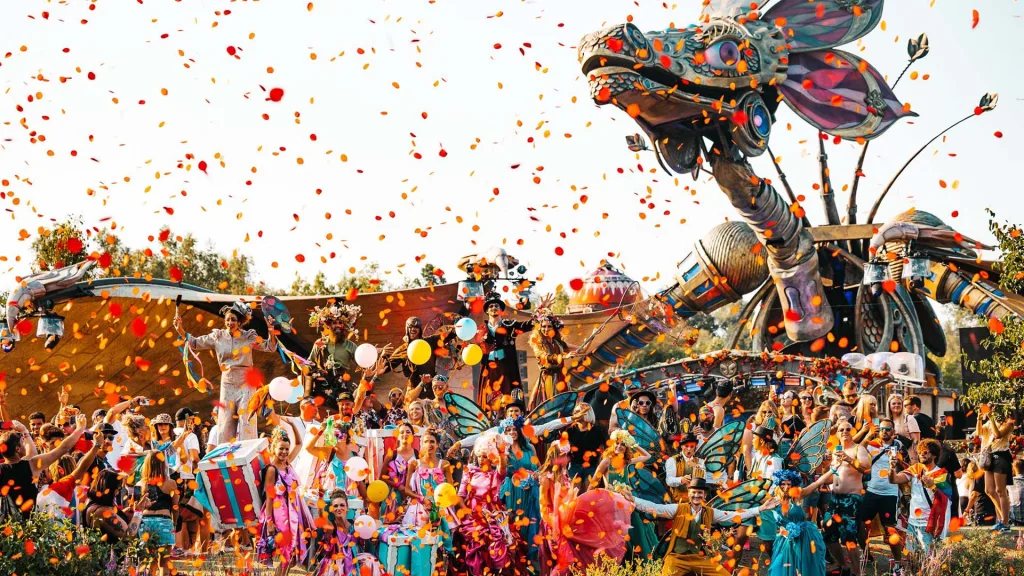
1. The Role of Hardtechno Festival Organizers: Architects of Experience
Before we dive into the technical side, it’s important to acknowledge the Hardtechno festival organizers or the architects who bring the vision to life. They design the experience, plan logistics, and ensure every aspect aligns to deliver a cohesive event.
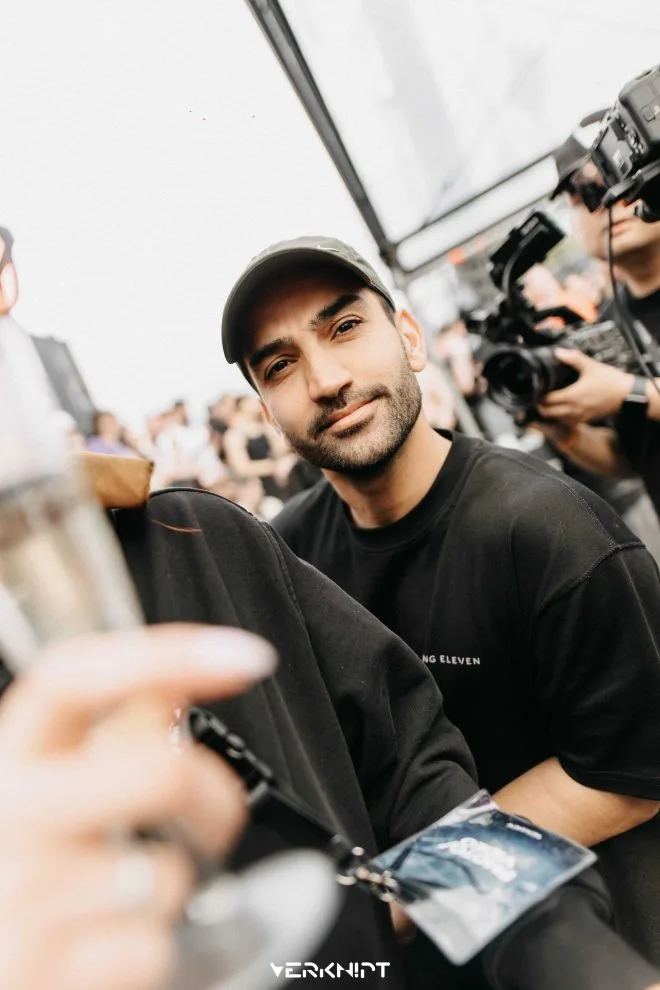
Key Roles
- Visionaries: Create the festival’s theme, style, and identity.
- Logisticians: Plan schedules, book artists, secure permits, and coordinate all departments.
- Budget Managers: Allocate funds across staging, artists, marketing, and sustainability efforts.
- Safety Experts: Develop crowd control measures and emergency plans.
- Sustainability Advocates: Design eco-friendly initiatives to reduce environmental impact.
How Do Festival Organizers Work at Hardtechno Festivals?
- Pre-Festival: Plan themes, create budgets, secure vendors, and book talent months in advance.
- During the Festival: Monitor operations, troubleshoot issues, and ensure on-site Festival Crews are synchronized.
- Post-Festival: Collect feedback, reconcile finances, and plan improvements for future events.
Collaborating with Key Hardtechno Festival Crews
- Artists and Agents: Align schedules, negotiate contracts, and provide hospitality.
- Technical Hardtechno Festival Crews: Ensure stage designs and technical setups align with the creative vision.
- Vendors: Organize food stalls, merchandise booths, and attendee services.
- Security Teams: Coordinate crowd management and emergency response protocols.
Challenges
- Unpredictable Weather: Rain, wind, or extreme heat can disrupt plans.
- Artist Cancellations: Changes in the lineup can affect ticket sales and schedules.
- Community Relations: Balancing local regulations with festival goals is often challenging.
Tools of the Trade
- Project Management Software: Platforms like Asana, Trello, or Monday.com help organizers track tasks, schedules, and deadlines across multiple teams.
- Ticketing Platforms: Services like Eventbrite, Ticketmaster, or custom ticketing solutions handle sales, attendee tracking, and data collection.
- Logistics Software: Tools like MapYourShow or custom venue mapping software aid in planning layouts, vendor spaces, and crowd flow.
- Budgeting Tools: Software like QuickBooks or Expensify allows organizers to allocate resources and track expenses in real time.
- Communication Platforms: Apps like Slack or Microsoft Teams facilitate seamless communication among diverse teams.
Did You Know?
- For larger festivals, data analytics from previous years’ ticket sales, attendee feedback, and social media trends play a crucial role in shaping the lineup and experience.
- The Coachella Valley Music and Arts Festival begins planning up to 18 months in advance, with organizers already working on the next event as the current one wraps up.
- Festivals in Europe like Glastonbury or Tomorrowland often require up to 500 permits to comply with local regulations, covering everything from noise limits to environmental impact assessments.
Fun Fact
- Burning Man, famous for its radical self-reliance ethos, has no “official” vendors. Instead, festivalgoers bring or trade goods, forcing organizers to focus more on infrastructure and crowd logistics than traditional vendor management.
- The first-ever Woodstock Festival (1969) was initially planned for 50,000 attendees. Due to overwhelming interest, over 400,000 people showed up, making it one of the most legendary but chaotic events in history—an organizer’s ultimate nightmare and dream combined!
2. Sound Engineers: Crafting the Hardtechno Festival’s Voice
The sound is the soul of any festival. Without a flawless audio experience, even the most talented artists can fall flat. Sound engineers at Hardtechno Festival Crews ensure that every note, bassline, and vocal hits the crowd exactly as intended.
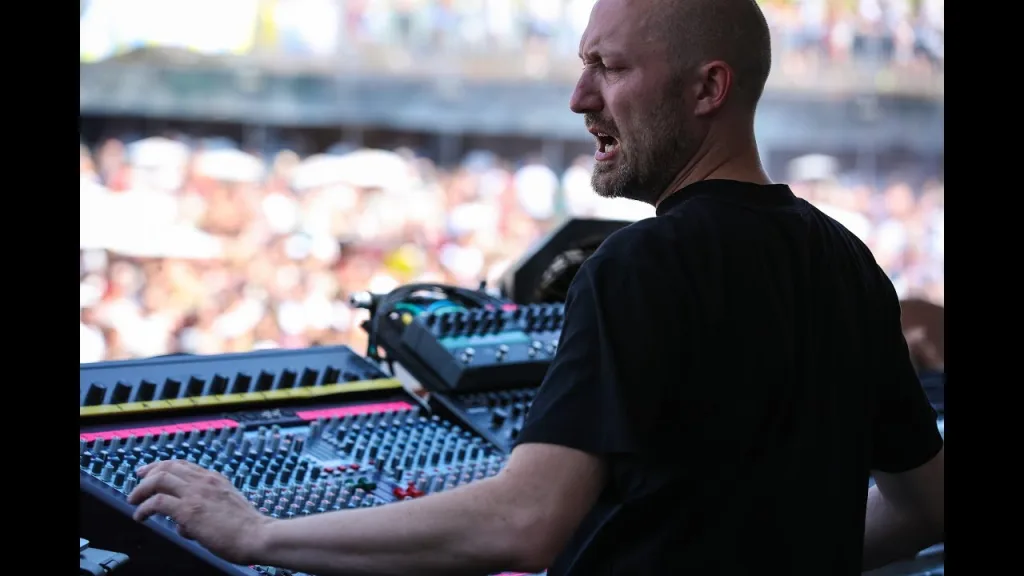
Key Roles
- Front of House (FOH) Engineer: Positioned in the audience area, FOH engineers control the overall sound the crowd hears. They adjust EQs, volume, and effects to optimize the listening experience.
- Monitor Engineer: Handles the on-stage sound, ensuring performers can hear themselves clearly through monitors or in-ear systems.
- Systems Technician: Sets up, aligns, and calibrates the entire sound system, ensuring even distribution across the venue.
- Stage Patch – The person(s) in charge of organising and communicating which microphone/mixers/DI is capturing what onstage, e.g. kick, snare, vocals, backing vocals etc.
How Do Lighting Technicians Enhance Hardtechno Festivals?
- Pre-Festival: Configure and test audio systems, set up mixing consoles, and align speaker arrays.
- During Performances: Adjust sound levels in real time to counter crowd noise or weather effects.
- Post-Festival: Dismantle audio setups and review performance data to refine future workflows.
Collaborating with Key Hardtechno Festival Crews
- Lighting Technicians: Synchronize sound and lighting cues for immersive experiences.
- Artists: Adjust audio levels based on individual performer preferences.
- Stage Technicians: Ensure microphones, instruments, and audio setups are stage-ready.
Challenges
- Outdoor Acoustics: Wind and crowd noise require constant monitoring and adjustment.
- Quick Turnovers: Transitioning between artists leaves little time to reset audio settings.
- Equipment Failures: Sound engineers must troubleshoot issues like blown speakers or faulty mics on the fly.
Tools of the Trade
Sound engineers are the architects of a festival’s auditory experience. They rely on cutting-edge technology to deliver crystal-clear sound that resonates with the crowd. Here’s what powers their work:
- Mixing Consoles: Digital mixers like the Avid VENUE S6L or Yamaha Rivage PM10 provide precise control over every audio channel, from vocals to instruments.
- Line Array Speakers: Systems from L-Acoustics, d&b audiotechnik, or Meyer Sound deliver uniform sound coverage across large venues.
- Microphones: Wireless and wired microphones such as Shure SM58 or Sennheiser EW G4 ensure clear and reliable audio transmission for performers.
- In-Ear Monitoring (IEM) Systems: Brands like Ultimate Ears or Shure PSM Series help artists hear their performance without external noise interference.
- Real-Time Sound Analysis Tools: Software like Smaart and Rational Acoustics helps engineers optimize speaker placement and equalization for the best possible sound quality.
- Audio Interfaces: Devices like Focusrite Scarlett or RME Fireface ensure seamless audio transfer between systems.
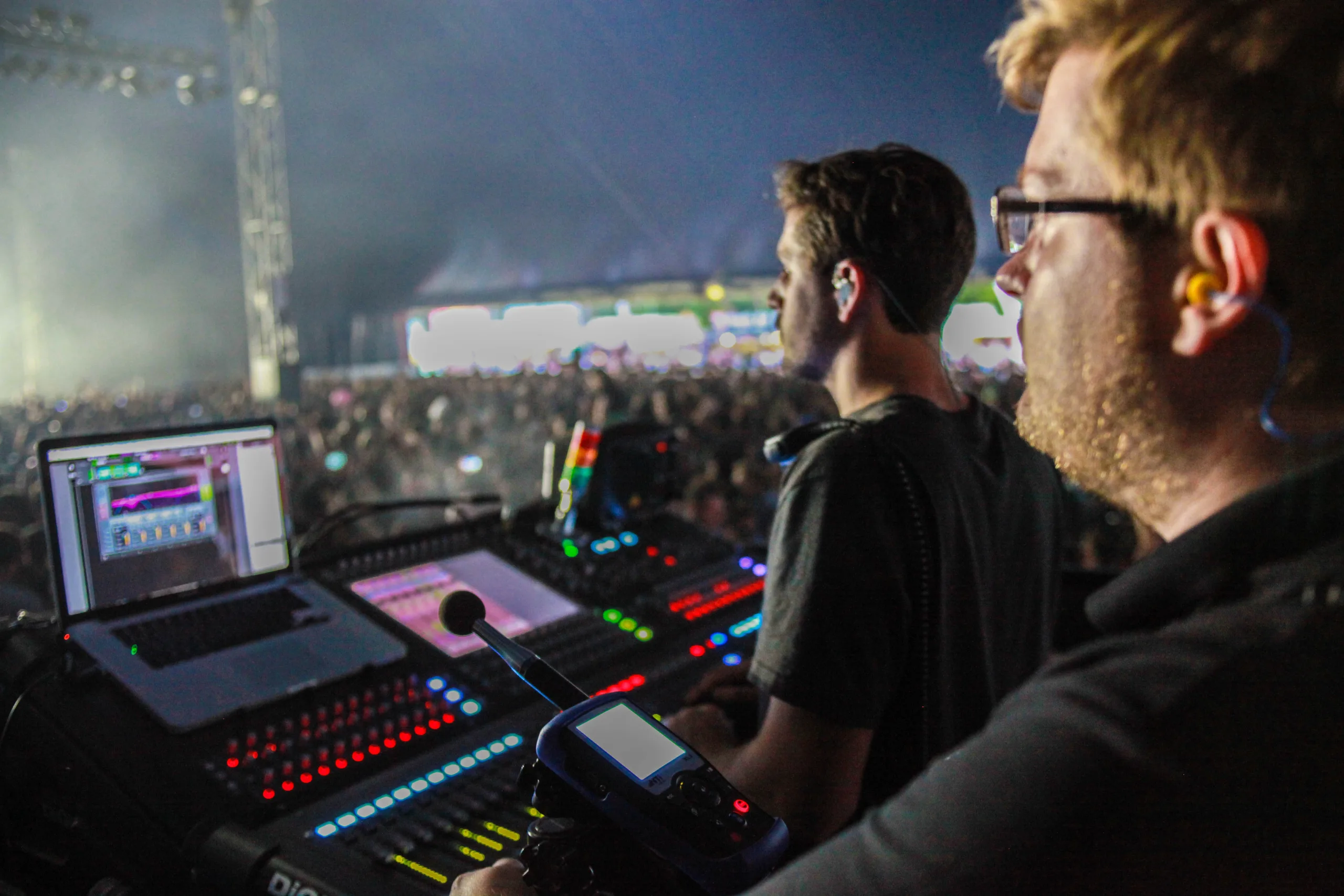
Did You Know?
- Pre-Programmed Show Files: Many sound engineers create custom “show files” tailored to specific artists. These files store EQ, gain, and effect settings, enabling quick and seamless setups regardless of the venue.
- Environmental Acoustics: Outdoor festivals require constant adjustments due to factors like wind direction, humidity, and crowd density, which can all affect sound clarity.
Fun Fact
- The Loudest Festival?: The Guinness World Record for the loudest festival sound level belongs to KISS during a performance in Ottawa, Canada, where sound levels hit 136 dB. However, most festivals aim to keep levels below 105 dB to avoid damaging attendees’ hearing.
- Sound Check Secrets: Before the festival gates open, sound engineers often test the system by playing popular tracks or white noise. At some festivals, the team plays their personal favorite songs, turning sound checks into mini dance parties for the Festival Crews!
- Many sound engineers carry personal custom earplugs to protect their hearing during high-decibel performances—they’re exposed to more noise than anyone else at the event!
3. Lighting Designers and Technicians: Painting the Sky with Light
Lighting is more than just illumination it’s a storytelling tool that sets the mood, heightens the energy, and amplifies the music. The lighting Hardtechno festival crews creativity and technical skill turn stages into visual masterpieces.

Key Roles
- Lighting Designer: Creates a lighting blueprint that aligns with the festival’s aesthetic and artist performances.
- Lighting Operator: Executes light cues during performances, using advanced consoles like grandMA3.
- Rigging Crew: Installs and positions lighting fixtures safely and efficiently.
How Do Lighting Technicians Enhance Hardtechno Festivals?
- Pre-Festival: Install and test fixtures, program lighting sequences, and weatherproof equipment.
- During Performances: Adjust effects in real time to enhance mood and energy.
- Post-Festival: Dismantle lighting rigs and store equipment for reuse.
Collaborating with Key Hardtechno Festival Crews
- Visual Effects Festival Crews: Align lighting colors and patterns with stage visuals.
- Sound Engineers: Sync lighting bursts with music cues and bass drops.
- Stage Technicians: Ensure trusses and lighting setups integrate with the stage design.
Challenges
- Dynamic Performances: Real-time adjustments require split-second precision.
- Weather Risks: Outdoor lighting must be shielded from rain and extreme temperatures.
- Energy Consumption: Managing high-power requirements while maintaining sustainability.
Tools of the Trade
Lighting designers and technicians rely on cutting-edge tools to create mesmerizing shows. Here are some essentials:
- Lighting Consoles: Advanced control boards like grandMA3 and Avolites allow operators to manage complex lighting rigs with precision, pre-program cues, and even run automated sequences.
- DMX Protocols: Digital multiplex (DMX) systems enable synchronized control of hundreds of lighting fixtures, ensuring smooth transitions and stunning effects.
- Intelligent Fixtures: Moving heads, wash lights, and LED panels offer unparalleled flexibility to create vibrant colors, dynamic beams, and immersive effects.
- Software Solutions: Programs like Capture or Lightwright help lighting designers visualize and pre-program shows before the first light is even installed.
- Lasers and Special Fixtures: High-powered laser projectors add dramatic flair, synchronized perfectly with the music.
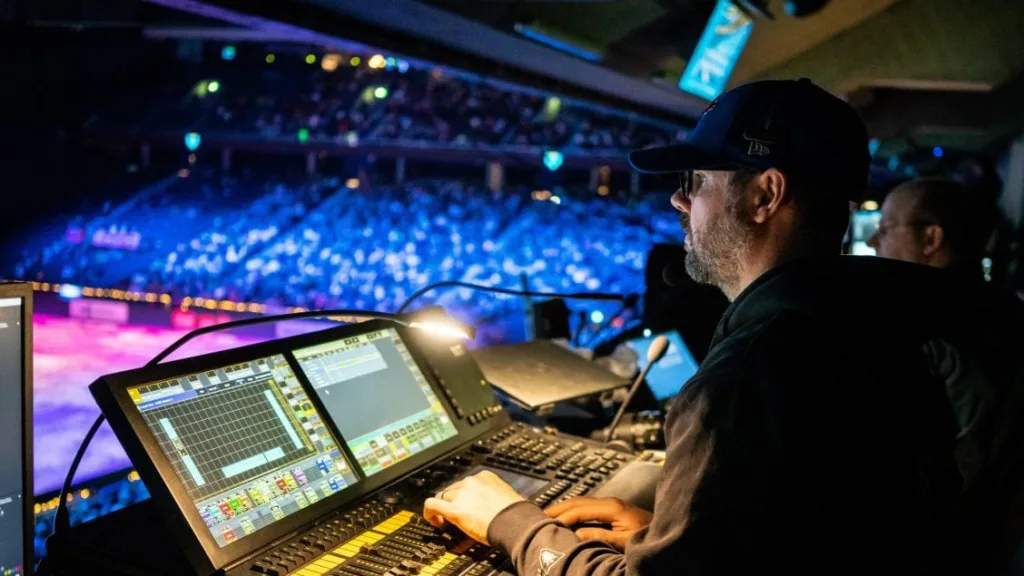
Did You Know?
- The largest lighting rig ever assembled for a festival was at EDC Las Vegas, featuring over 30,000 individual fixtures. Each was precisely timed to match the music across multiple stages.
- Many festivals use timecode technology to sync lighting cues with music beats, ensuring perfect harmony between sound and visuals.
- LED technology has revolutionized festival lighting, reducing energy consumption by up to 50% compared to traditional incandescent fixtures.
Fun Fact:
- Some lighting teams name their fixtures during setup to keep track of complex rigs. You might hear operators referring to “Big Bertha” or “Spotzilla” during a show!
- The strobe light effect commonly used in hard techno sets is scientifically proven to heighten sensory stimulation, making the audience feel more immersed in the experience.
- Certain festivals like Tomorrowland invest months in pre-visualization, where designers simulate the entire lighting experience in 3D software to ensure flawless execution.
4. Visual Effects Teams: Bringing Stages to Life
Visuals effect Hardtechno Festival Crews add another dimension to Hardtechno festivals, captivating the audience with animated backdrops, surreal projections, and live visuals that respond to the music.

Key Roles
- Visual Designer: Creates animations, projections, and themes tailored to artists.
- VJ (Video Jockey): Operates software like Resolume or MadMapper to mix visuals live.
- LED Technicians: Set up and manage massive LED walls.
What Do Visual Effects Teams Do at Hardtechno Festivals?
- Pre-Festival: Design visuals, program projection sequences, and set up equipment.
- During Performances: Sync visuals with music tempo and stage lighting in real time.
- Post-Festival: Dismantle screens and evaluate visual performance for improvements.
Collaborating with Key Hardtechno Festival Crews
- Lighting Designers: Coordinate colors and patterns for cohesive visuals.
- Artists: Customize visuals to match their unique themes.
- Stage Managers: Align visual setups with stage layouts and artist transitions.
Challenges
- Technical Glitches: High-resolution visuals demand robust hardware, which can fail under strain.
- Overpowering Visuals: Balancing brightness and clarity without overshadowing the performers.
- Environmental Adjustments: Bright sunlight at outdoor festivals can reduce LED visibility.
Tools of the Trade
Visual effects teams in Hardtechno Festival Crews use an arsenal of high-tech tools to captivate audiences and turn stages into living art. Here are their go-to essentials:
- Media Servers: Powerful systems like Resolume Arena, Hippotizer, and Disguise manage and synchronize video content across multiple LED walls and projection surfaces.
- LED Panels: Modular LED walls provide high-resolution backdrops that can adapt to different stage designs and sizes.
- Projection Mapping Tools: Software like MadMapper and TouchDesigner allows designers to map visuals onto irregular surfaces, creating stunning 3D illusions.
- Live Visual Controllers: Devices such as Novation Launchpads give VJs tactile control over visuals, allowing them to react instantly to the music.
- AR and XR Technology: Advanced setups bring augmented reality (AR) and extended reality (XR) elements to live stages, blending the real world with digital creations.
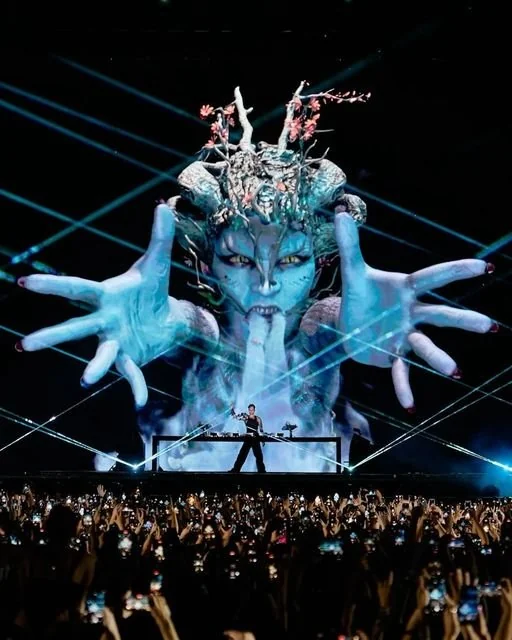
Did You Know?
- The first-ever use of projection mapping at a festival was at Coachella 2010, where a stage was transformed into a living, breathing canvas of visuals.
- Some festivals now use interactive visuals, where audience movement or sound levels influence what’s displayed on screens.
- The largest LED screen ever used at a festival was at Ultra Music Festival, spanning over 300 square meters. That is equivalent to a basketball court!
Fun Fact:
- VJs (Video Jockeys) often freestyle visuals live, much like DJs mixing tracks. No two performances are ever the same!
- Many festivals incorporate AI-generated visuals, where algorithms create dynamic, unpredictable graphics based on the music’s tempo and intensity.
- Ever noticed visuals that seem perfectly timed with lyrics or beats? That’s MIDI triggering, where the DJ’s mixer sends signals to the visual software to sync music and visuals seamlessly.
5. Stage Technicians: The Builders of Festival Dreams
The stage is the centerpiece of any festival, and its construction is a feat of engineering and creativity. Stage technicians Hardtechno Festival Crews handle everything from assembly to ensuring performers’ safety.
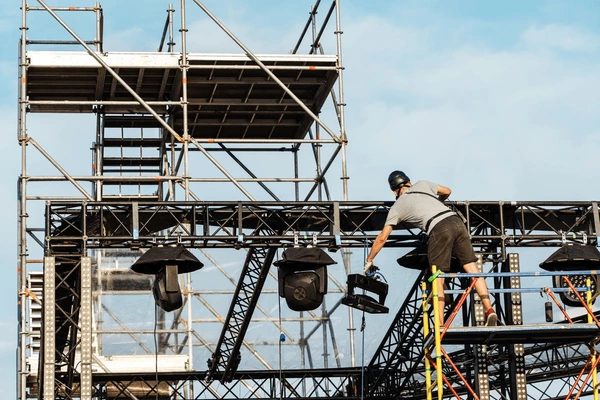
Key Roles
- Stage Manager: Oversees all stage activity, from setups to changeovers.
- Rigging Specialists: Secure trusses, sound systems, and lighting equipment.
- Backline Technicians: Manage artist instruments and DJ gear.
How Do Stage Technicians Build Hardtechno Festival Stages?
- Pre-Festival: Build modular stages, install trusses, and test stage safety.
- During Performances: Manage transitions, fix on-stage equipment issues, and support artists.
- Post-Festival: Disassemble the stage and transport equipment to storage.
Collaborating with Key Hardtechno Festival Crews
- Sound and Lighting Hardtechno Festival Crews: Coordinate stage layouts to accommodate technical setups.
- Artists: Ensure instruments and equipment are prepped for their performances.
- Safety Teams: Regularly inspect the stage for hazards during the festival.
Challenges
- Tight Timelines: Quick transitions between artists leave little room for error.
- Safety Concerns: Stages must withstand weather and heavy loads while ensuring crew safety.
- Technical Complexity: Large stages often require intricate setups involving multiple teams.
Tools of the Trade
Stage technicians rely on a variety of tools and equipment to build and maintain the Hardtechno festival’s physical centerpiece. Here’s what’s in their toolkit:
- Modular Staging Systems: Platforms like Stageline and Prolyte allow for rapid assembly and flexibility in design, accommodating stages of all sizes and configurations.
- Rigging Equipment: Heavy-duty trusses, shackles, and motors are used to safely suspend lighting, screens, and special effects above the stage.
- Lifting Gear: Tools like chain hoists and winches help technicians handle massive loads efficiently and safely.
- Safety Gear: Helmets, harnesses, and anti-slip footwear are essential for working at heights and preventing accidents.
- Power Tools: Drills, wrenches, and impact drivers are staples for assembling and securing stage elements.
- CAD Software: Programs like AutoCAD or Vectorworks are used for precise stage design and layout planning.
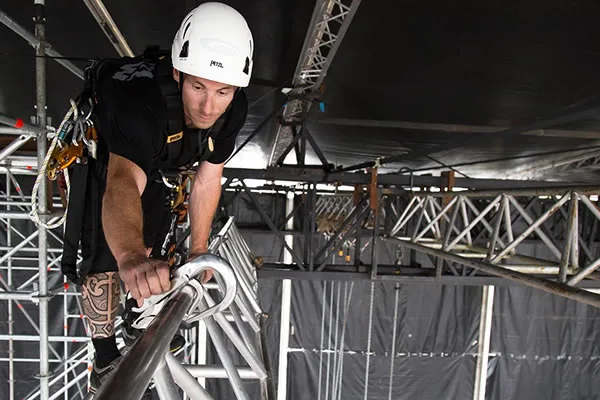
Did You Know?
- The largest festival stage ever built was at Rock in Rio, requiring over 500 tons of materials and taking nearly a month to construct.
- Wind safety tests are a mandatory part of outdoor stage setups to ensure structures can withstand gusts of up to 70 km/h or more.
- Many festival stages are modular and reusable, designed to be dismantled and reassembled at different events, reducing environmental impact and costs.
Fun Fact:
- Some festivals nickname their stages—“The Beast” or “Sky Fortress”—because of their immense size and complexity.
- Backline technicians have been known to write inspirational or humorous notes for performers on their equipment cases, providing a little morale boost before the show.
- The design of modular stages, such as those at Tomorrowland, often includes hidden trapdoors for performers or stagehands to quickly access different levels or swap gear unnoticed.
- Modular stages, like those used at Tomorrowland, can be disassembled and reused across multiple events, reducing waste and costs.
6. Power Technicians: Keeping the Lights On
Powering a festival is no small feat. The technical Hardtechno Festival Crews responsible for power ensures everything from lights to sound runs smoothly without interruptions.
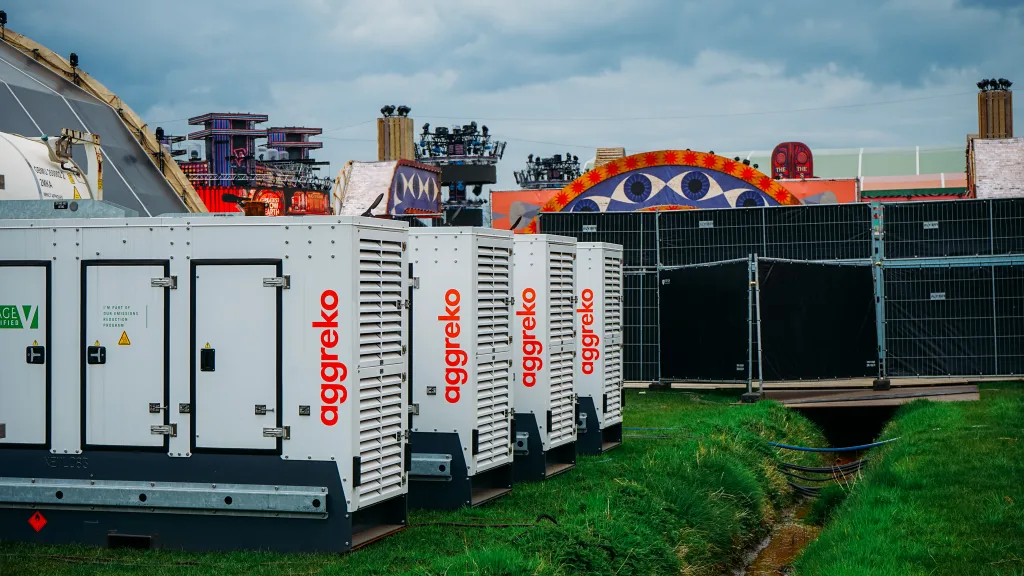
Key Roles
- Power Technicians: Set up and monitor generators, transformers, and distribution panels.
- Systems Integrators: Design energy-efficient systems, often incorporating renewable sources.
How Do Power Technicians Support Hardtechno Festivals?
- Pre-Festival: Install power distribution systems and test for load capacity.
- During Performances: Monitor power flow to prevent outages or surges.
- Post-Festival: Safely shut down and dismantle power systems.
Collaborating with Key Hardtechno Festival Crews
- Sound Engineers: Ensure stable power for speakers and amplifiers.
- Lighting Designers: Provide consistent electricity for high-energy light displays.
- Vendors: Supply power to food stalls and attendee facilities.
Challenges
- Load Balancing: Distributing power evenly to avoid overloads.
- Backup Systems: Generators must be on standby in case of primary power failure.
- Environmental Concerns: Reducing reliance on diesel generators by using hybrid or solar solutions.
Tools of the Trade
Power technicians Hardtechno Festival Crews bring the energy to festivals literally. Their work ensures every sound, light, and special effect operates smoothly. Here’s what they use to keep the lights on:
- Generators: Industrial-grade generators like Caterpillar or Atlas Copco provide reliable power for large-scale events.
- Distribution Panels: Portable power distribution systems safely deliver electricity to various festival zones, from stages to vendor stalls.
- Load Balancers: Devices that evenly distribute power across equipment to prevent overloading and blackouts.
- Uninterruptible Power Supplies (UPS): Battery systems act as backups, ensuring that critical systems like soundboards or lighting rigs don’t fail during an outage.
- Power Cables and Connectors: Heavy-duty cables with waterproof connectors (e.g., CEE plugs) are crucial for outdoor setups.
- Monitoring Systems: Tools like PowerLogic or custom dashboards allow technicians to track energy consumption in real-time.
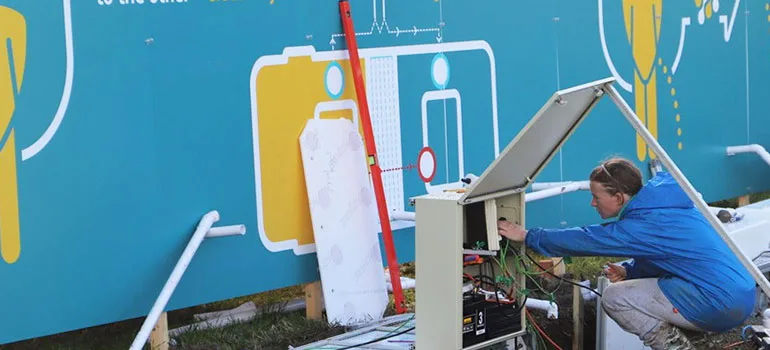
Did You Know?
- Festivals like Glastonbury and Burning Man have adopted hybrid power solutions combining solar panels and biodiesel generators, reducing their carbon footprint.
- The average music festival uses enough power to sustain a small town for a day!
- Power technicians often create color-coded cable systems to avoid confusion during setup and teardown, ensuring no one accidentally unplugs the main stage.
Fun Fact?
- Some festivals use “silent” generators to minimize noise pollution, allowing the music to shine without background hums.
- Did you know that some festivals are experimenting with Pee Power Technology to generate electricity from urine? This innovative system uses microbial fuel cells (MFCs) to convert urine into electricity.
7. Special Effects Teams: Adding the Wow Factor
From pyrotechnics to confetti showers, special effects Hardtechno Festival Crews add the final layer of excitement to festivals, leaving the audience in awe.
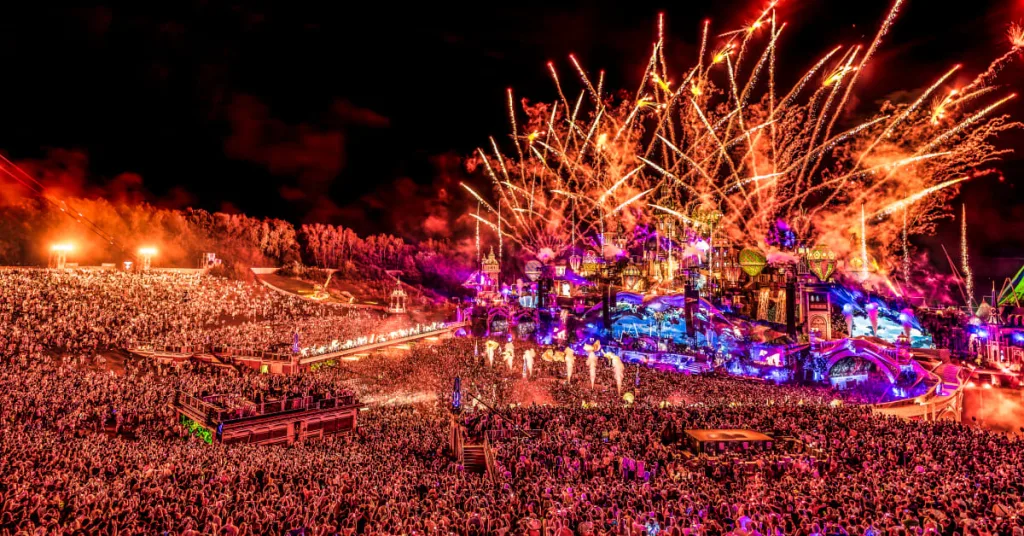
Key Roles
- Pyrotechnicians: Handle fireworks, flame jets, and sparklers.
- Effects Operators: Operate fog machines, CO2 jets, and confetti cannons.
How Do Special Effects Teams Work at Hardtechno Festivals?
- Pre-Festival: Test and position special effects equipment.
- During Performances: Deploy effects in sync with music and lighting.
- Post-Festival: Safely dismantle equipment and dispose of materials.
Collaborating with Key Hardtechno Festival Crews
- Lighting and Sound Festival Crews: Align effects with audio-visual cues.
- Stage Managers: Ensure effects don’t interfere with artist performances or stage layouts.
Challenges
- Safety Regulations: Pyrotechnics require strict adherence to safety protocols.
- Weather Conditions: Rain or high winds can delay or cancel certain effects.
- Environmental Concerns: Festivals now prioritize biodegradable materials for confetti and other effects.
Tools of the Trade
Special effects Hardtechno Festival Crews create the unforgettable “wow moments” that take festivals to the next level. Here are the essential tools they use to dazzle the crowd:
- Pyrotechnics Systems: Flame jets, spark machines, and firework launchers, controlled with systems like Galaxis or FireOne for precise timing.
- CO2 Cannons and Fog Machines: Devices like the CryoFX CO2 Jet create dramatic bursts of smoke or cool effects synced to music.
- Confetti and Streamer Launchers: Tools like MagicFX Confetti Blasters shower the crowd with colorful bursts during peak moments.
- Laser Projectors: High-powered lasers, often synchronized with music, create intricate light patterns in the air.
- Bubble and Foam Machines: Quirky additions that turn parts of the venue into interactive, playful spaces.
- Control Software: Programs like DMXIS and Show Control allow operators to sync effects with music and lighting seamlessly.
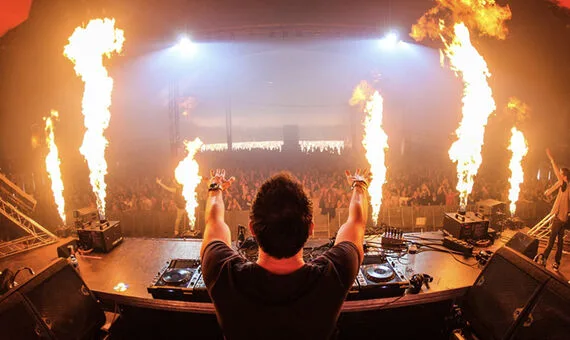
Did You Know?
- The record for the largest confetti blast at a festival was set at Tomorrowland, releasing over 2 million biodegradable confetti pieces in one moment.
- Many pyrotechnics systems are now eco-friendly, using smokeless compounds and recyclable materials.
- Special effects teams often perform dummy runs before the event, testing equipment to ensure perfect execution and safety compliance.
Fun Fact:
- Some festivals have incorporated snow machines to mimic a winter wonderland vibe, even during summer events!
- Special effects Hardtechno Festival Crews often work with artists to synchronize explosions or CO2 blasts to their signature drops, making each performance unique.
8. Security, Vendors, Entertainers, Promoters, Dancers, and Medical festival crews
Festivals are vibrant, multi-faceted events where diverse Hardtechno festival crews collaborate to create unforgettable experiences. From maintaining safety and delivering captivating performances to ensuring attendees’ well-being, every role is crucial. Let’s explore how security Hardtechno festival crews, vendors, entertainers, promoters, dancers, and medical festival crews work behind the scenes to make festivals possible.
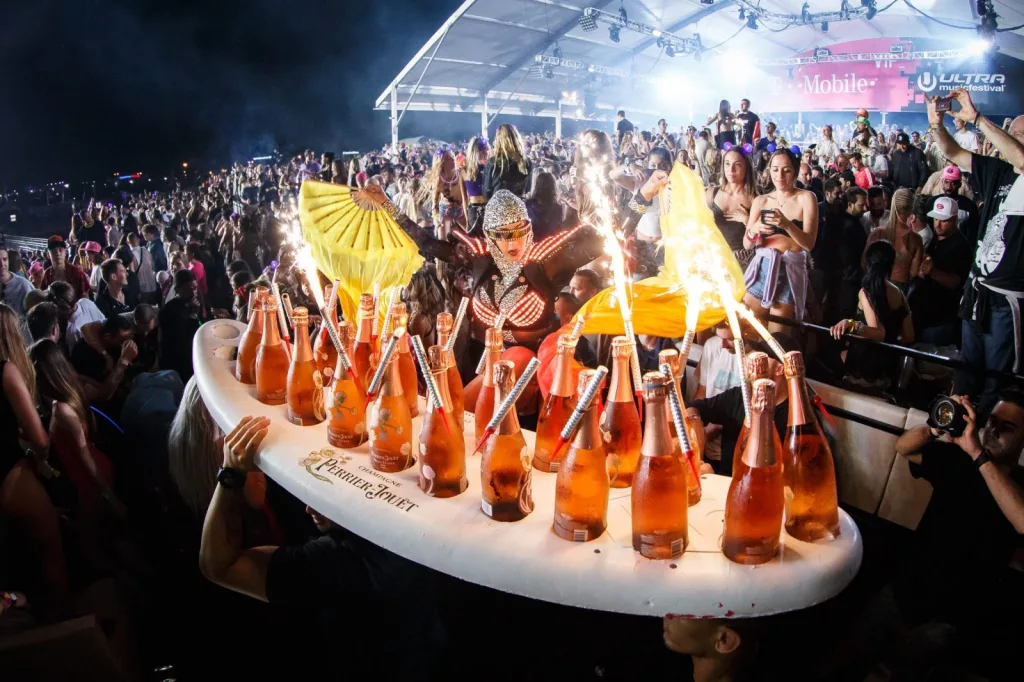
Key Roles
- Security festival crews: Safeguard attendees, festival crews, performers, and festival equipment.
- Vendors: Provide food, drinks, and unique festival merchandise.
- Entertainers and Performers: Deliver music, shows, and crowd engagement.
- Promoters: Build hype and drive ticket sales through marketing campaigns.
- Dancers: Enhance performances with energetic routines and visual storytelling.
- Medical festival crews: Ensure the health and safety of attendees and festival crews, addressing emergencies and providing care.
How Do These festival crews Work at Hardtechno Festivals?
Security festival crews
- Monitor festival grounds, manage crowd control, and conduct bag checks.
- Protect restricted areas, including backstage zones and equipment storage.
- Coordinate with medical festival crews during emergencies to ensure rapid response.
Vendors
- Set up food, beverage, and merchandise booths tailored to the festival’s theme.
- Collaborate with organizers to implement sustainable waste practices.
- Adapt to fluctuating crowd sizes and manage supply chain logistics.
Entertainers and Performers
- Rehearse extensively to deliver polished and engaging live acts.
- Sync with technical festival crews for lighting, sound, and special effects.
- Connect with the audience through interactive performances and crowd engagement.
Promoters
- Execute strategic marketing campaigns across social media, email, and partnerships.
- Secure sponsorship deals to fund additional festival amenities.
- Manage ticket sales platforms and track audience engagement metrics.
Dancers
- Perform choreographed routines that elevate musical performances.
- Participate in parades, flash mobs, or roaming acts to entertain attendees.
- Collaborate with lighting and sound teams to synchronize their movements.
Medical festival crews
- Operate first aid stations and provide on-the-spot care for injuries or illnesses.
- Prepare for emergency scenarios, including severe weather or large-scale incidents.
- Offer mental health support to attendees experiencing anxiety, dehydration, or overstimulation.
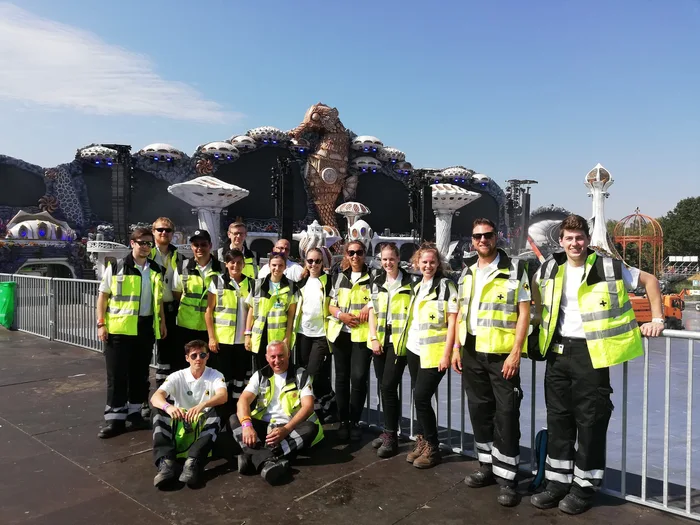
Collaborating with Key Hardtechno Festival Crews
Security Teams
- Partner with medical festival crews to manage emergencies effectively.
- Work with promoters to maintain order during high-profile events or artist meet-and-greets.
- Collaborate with vendors to secure high-traffic areas and manage crowd flow.
Vendors
- Coordinate with promoters for featured vendor promotions or giveaways.
- Partner with medical teams to ensure food safety and proper sanitation.
Entertainers and Performers
- Align with dancers to create cohesive on-stage narratives.
- Work with technical festival crews to ensure flawless audio-visual synchronization.
Promoters
- Collaborate with artists and dancers to highlight exclusive acts in promotional material.
- Coordinate with security to manage ticketing and crowd dynamics.
Dancers
- Rehearse with stage managers and performers for seamless integration.
- Work closely with visual and lighting designers to enhance stage aesthetics.
Medical Teams
- Communicate with security festival crews to locate and assist distressed attendees quickly.
- Coordinate with organizers to place first aid stations strategically.
- Work with vendors to ensure proper handling of food and beverages.
Challenges
- Security festival crews: Managing crowd dynamics, unpredictable behavior, and emergencies.
- Vendors: Keeping up with demand during peak festival hours while maintaining quality.
- Entertainers and Dancers: Adapting to weather, technical issues, or changes in stage setup.
- Promoters: Navigating a competitive market and achieving ticket sales targets.
- Medical festival crews: Addressing multiple incidents simultaneously in crowded environments.
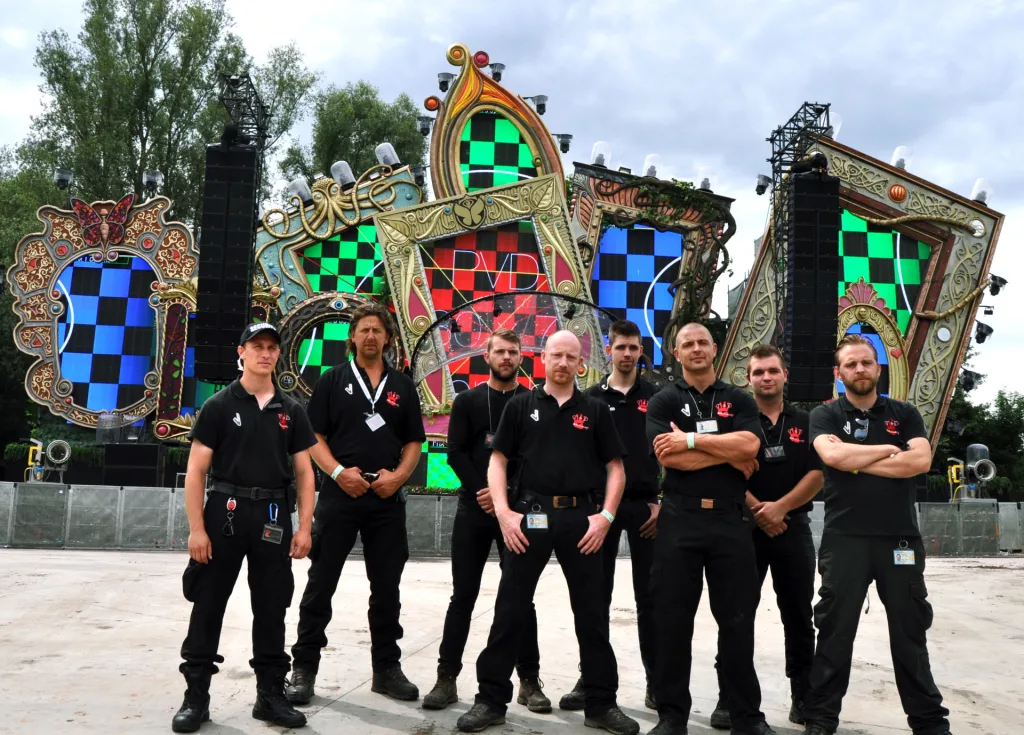
Tools of the Trade
Security festival crews
- Surveillance cameras, two-way radios, and first emergency response kits.
- Metal detectors and crowd barriers for controlled entry and movement.
Vendors
- Point-of-sale (POS) systems, portable cooking equipment, and custom booth displays.
- Eco-friendly packaging and waste management supplies.
Entertainers and Dancers
- High-quality instruments, costumes, and in-ear monitors.
- Rehearsal spaces and choreography software.
Promoters
- Social media scheduling tools, email marketing platforms, and ticketing dashboards.
- Analytics software to measure campaign performance.
Medical festival crews
- First aid kits, defibrillators, and mobile medical tents.
- Hydration stations and mental health resources for festivalgoers.
Did You Know?
- Tomorrowland’s medical system is so advanced that it includes mobile mini-clinics equipped with ECG machines and oxygen therapy units. These clinics can stabilize patients on-site, reducing the need for hospital transfers and ensuring quicker care for festival-goers.
- Food vendors at Tomorrowland can serve over 400,000 meals in a single weekend.
- Many security festival crews now use drones to monitor large crowds and identify safety risks.
- At festivals like Burning Man, entertainers often double as volunteers, contributing to the event’s communal spirit.
Fun Fact
- Some medical festival crews use golf carts equipped with stretchers to navigate crowded festival grounds quickly.
- Vendors at Coachella once competed to create a custom menu item inspired by the festival’s headlining acts.
- Dancers at festivals like Ultra Music Festival are known to engage audiences by leading impromptu dance lessons or flash mobs.
- Some festivals host pre-event promotional stunts, like surprise performances in public spaces, to drum up excitement.
Conclusion
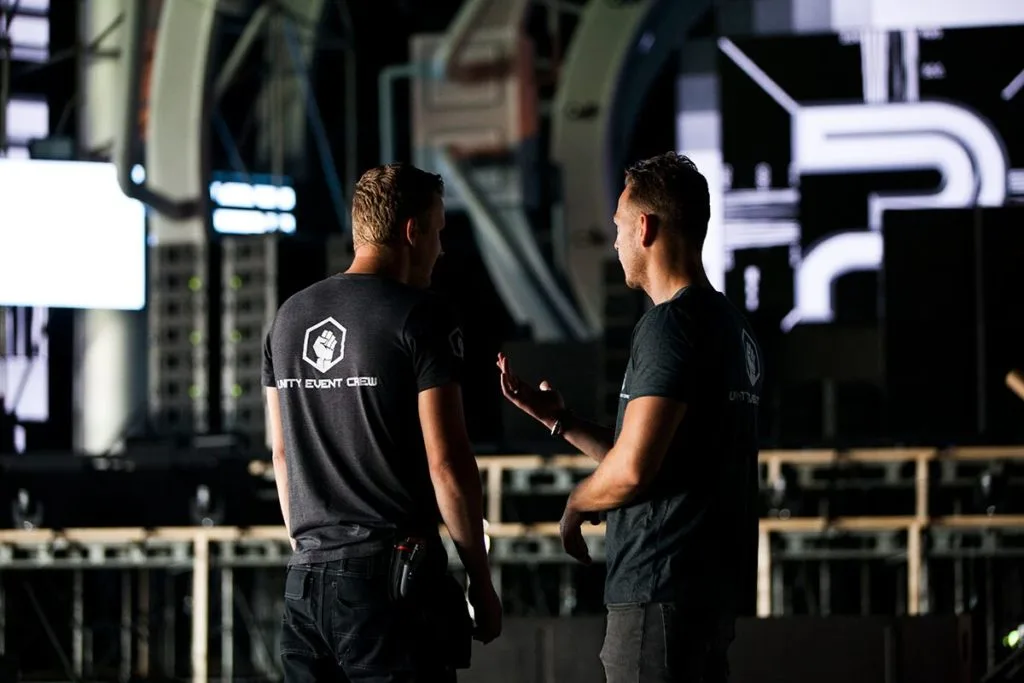
Behind every breathtaking stage, every pulse-pounding bass drop, and every dazzling light show is the technical Hardtechno festival crews the true backbone of every festival. From sound engineers crafting the perfect auditory experience to lighting designers painting the sky, visual effects teams creating immersive worlds, and stage technicians building festival dreams, their work ensures the magic happens seamlessly.
Their expertise, teamwork, and ability to overcome challenges under pressure transform a simple venue into an unforgettable world of music, light, and connection. The next time you’re mesmerized by a festival’s spectacle, remember the countless hands working behind the scenes to make it all possible. Festivals aren’t just about the music or the performers; they are a testament to the ingenuity and dedication of these unsung heroes.
Whether it’s the power technicians keeping the lights on, the security ensuring your safety, or the medical teams ready to assist, every crew member plays a vital role in creating a safe, immersive, and extraordinary experience for attendees.
Takeaway: The festival crews are not just the backbone but the heart and soul of every Hardtechno festival. Their relentless effort ensures that the magic of the moment stays with you long after the last beat fades.
Frequently Asked Questions (FAQ)
How do Hardtechno festivals work behind the scenes?
Festivals involve a complex coordination of various Festival Crews, including festival organizers, sound engineers, lighting technicians, stage builders, and power technicians. Each team specializes in a specific area, such as crafting the sound, designing the stage, or ensuring a stable power supply. Organizers oversee the entire operation, ensuring that all elements work in harmony to deliver an unforgettable experience.
What does a sound engineer do at festivals?
Sound engineers are responsible for delivering clear and immersive audio experiences. They manage everything from setting up speaker systems and mixing sound for the audience to ensuring performers hear themselves properly on stage. Their work includes adjusting audio levels in real time to match the dynamics of the performance and the acoustics of the venue.
What is the role of lighting technicians at festivals?
Lighting technicians design and operate visual lighting effects that align with the music and stage theme. They set up advanced lighting systems, program light sequences, and work closely with other Festival Crews to create a cohesive visual experience. Their expertise transforms stages into vibrant, dynamic spaces that amplify the energy of the music.
How do special effects teams enhance Hardtechno festivals?
Special effects teams add a “wow factor” to festivals by using pyrotechnics, CO2 jets, fog machines, confetti cannons, and even bubble machines. They synchronize these effects with music and visuals to create thrilling moments for the audience. Safety and precision are critical aspects of their work.
How are festival stages built?
Stage technicians build modular stages, secure trusses for lighting and sound equipment, and ensure structural safety. They collaborate with sound and lighting Festival Crews to create a functional and visually stunning setup. After the event, they dismantle the stage and store equipment for future use.
What challenges do power technicians face during Hardtechno festivals?
Power technicians must distribute electricity evenly across all systems to avoid overloads and blackouts. They also implement backup systems, such as generators, to ensure uninterrupted power. In eco-conscious festivals, power technicians design hybrid solutions using renewable energy sources like solar panels or batteries.
How do festivals ensure safety for the technical crew?
Safety is a top priority at festivals. Technical Festival Crews use personal protective equipment (PPE) such as helmets and harnesses. Rigging specialists secure overhead equipment, and stages undergo strict testing to withstand environmental factors like wind and rain. Clear communication between teams ensures hazards are minimized.
What tools do technical crews use during Hardtechno festivals?
– Sound Engineers: Mixing consoles, speaker systems, and real-time sound analysis software.
– Lighting Technicians: Advanced lighting consoles, DMX systems, and intelligent fixtures.
– Stage Technicians: Rigging equipment, modular staging systems, and CAD software.
– Power Technicians: Generators, distribution panels, and UPS systems.
– Special Effects Festival Crews: Pyrotechnic controllers, fog machines, and laser projectors.What makes festivals sustainable?
Sustainability initiatives include using renewable energy sources, encouraging recycling, and reducing single-use plastics. Some festivals also design modular stages and LED lighting systems to lower energy consumption. Collaborating with local communities to minimize environmental impact is becoming a common practice.
How far in advance do Hardtechno festivals plan for their technical setups?
Large festivals often begin planning technical setups 12 to 18 months in advance. This includes designing stages, booking crews, technical Festival Crews, securing equipment, and conducting pre-visualization sessions using 3D software to simulate the event.
Why do Hardtechno festivals prefer tokens over real money or bank cards for transactions?
Festivals prefer tokens over real money or bank cards because they simplify transactions, enhance security, and improve overall festival management. Tokens allow for faster service at bars and food stalls, eliminating the need for making change or using card machines, which can face connectivity issues in remote locations. They also reduce the handling of cash by vendors, minimizing theft risks, and streamline vendor management by allowing easy redemption for real money after the event.
Why do Hardtechno festivals use eco coins, and how do they work?
Festivals use eco coins to promote sustainability and reduce waste, especially when it comes to disposable items like cups, plates, and utensils. The system often works like this:
– Deposit for Cups: When you purchase a drink, you pay a small deposit for the cup. This deposit is usually in the form of an eco coin or token.
– Cup Exchange: To get your next drink, you hand in your empty cup and receive a new drink without paying another deposit.
– Eco Coin Refund: If you don’t want another drink, you can return your cup and get your eco coin back, or keep the coin as a souvenir.
Stay Connected:
Stay updated with the latest in the hard techno scene by subscribing to our newsletter and following us on social media:
- Instagram:
- Facebook:
- Twitter:
Tags: #FestivalCrew #BehindTheScenes #MusicFestivals #FestivalTech #FestivalSetup #FestivalOrganizers #FestivalPlanning #SoundEngineers #LightingTechnicians #StageTechnicians #PowerTechnicians #SpecialEffectsTeams #VisualEffectsTeams #FestivalAudio #FestivalLighting #StageBuilding #FestivalPowerSupply #FestivalVisuals #Pyrotechnics #FestivalCrews
Related Articles:
- What is Hard Techno Livesets.
- What is hardtechno?
- What is a liveset?
- What is a DJ mix?
- What Is a DJ Booth?
- Hardtechno DJ Set vs Liveset: What’s the Difference?
References and Resources:
Event Production Resources
- Chisel, Jake. Event Production Handbook.
- International Live Events Association (ILEA). “Insights on Technical Crew Roles.” ILEA Website
Festival-Specific Examples
- Tomorrowland: Explore their technical innovations and sustainability initiatives. Official Tomorrowland Website
- Glastonbury Festival: Sustainability practices and crew management. Official Glastonbury Festival Website
- Coachella: Case studies on creative stage designs. Official Coachella Website
Technical Equipment and Tools
- L-Acoustics: Leading provider of sound systems for festivals. L-Acoustics Website
- MA Lighting: Information on grandMA3 lighting consoles. MA Lighting Website
- Resolume Software: Video mapping and live visuals. Resolume Website
- Smaart Sound Analysis Tools: Real-time sound optimization. Rational Acoustics Website
Sustainability in Festivals
- A Greener Festival (AGF): Research on eco-friendly festival practices. AGF Website
- Hybrid power solutions in festivals: Case studies from Burning Man.
Insights from Industry Professionals
- Interviews with stage managers and lighting designers in Projection, Lights & Staging News (PLSN). PLSN Website
- Festicket’s blog on crowd management and festival logistics.
Safety and Regulations
- Occupational Safety and Health Administration (OSHA): Guidelines for stage safety. OSHA Website
- National Fire Protection Association (NFPA): Standards for pyrotechnics and special effects. NFPA Website
Fun Facts and Industry Trivia
- Guinness World Records: Loudest festival sound levels and record-breaking stages. Guinness World Records
- Documentary: Under the Electric Sky (EDC). IMDb Link
- Documentary: The Glastonbury Experience.
Specialized Roles and Technology
- DJ Tech Tools: Trends in VJ (Video Jockey) technologies. DJ Tech Tools Website
- Meyer Sound: Professional audio gear insights. Meyer Sound Website
- Focusrite: Leading audio interfaces for live performances. Focusrite Website
General Event Management Guides
- Allen, Judy. Event Planning: The Ultimate Guide to Successful Meetings and Events.
Sound Engineering and Audio Technology
- University of Huddersfield. “What is a Sound Engineer?” Huddersfield University Music Technology Page
- Berklee College of Music. Explore careers in sound and lighting technology. Berklee College Website
Lighting and Visual Effects
- Berklee College of Music. “Lighting Technician Careers.” Berklee Lighting Technician Careers
- Wikipedia. “Lighting Technician.” Wikipedia Entry on Lighting Technicians
Stage and Event Technicians
- Wikipedia. “Theatrical Technician.” Wikipedia Entry on Theatrical Technicians
- Wikipedia. “Event Technician.” Wikipedia Entry on Event Technicians
Industry Insights and Case Studies
- Mixmag NL. “Verknipt ADE Edition Digital Magazine.” Mixmag NL Article
General Knowledge
- Wikipedia. General reference for additional details on roles and concepts. Wikipedia Homepage
Subscribe!
Subscribe to our newsletter to get the latest hard techno livesets, artist news, and exclusive content delivered straight to your inbox.
Note: This article “The Ultimate Guide to Hardtechno Festival Crews: The Unsung Heroes of 1’s Festivals” is regularly updated to provide you with the latest insights and developments in the Hard Techno scene. Last updated on [27-12-2024].
Note: All images used are for illustrative purposes.
Written by Hatelise, a passionate electronic music enthusiast and hard techno aficionado dedicated to sharing the energy and excitement of the scene.
Need more hard techno in your life? Check out our curated playlists and let the music speak for itself.
Note to Hatelise; still to optimize for SEO